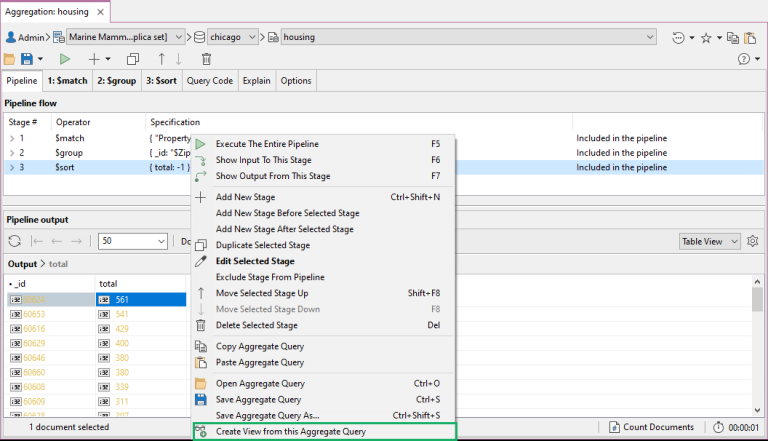

Thus with this stage we will increase the amount of documents for the next stage.Uses db.collection.aggregate and $group to perform the data grouping.Ģ.1 The following example groups by the “hosting” field, and display the total sum of each hosting. Overview In this tutorial, well take a dive into the MongoDB Aggregation framework using the MongoDB Java driver. When using an array, the data is kind of pre-joined and this operation will be undone with this to have individual documents again. $unwind − This is used to unwind document that are using arrays. Typically, you use aggregation operations to group documents by specific field values and perform aggregations on the grouped documents to return computed results. $limit − This limits the amount of documents to look at, by the given number starting from the current positions. MongoDB aggregation operations allow you to process multiple documents and return the calculated results. $skip − With this, it is possible to skip forward in the list of documents for a given amount of documents. $group − This does the actual aggregation as discussed above. Definition db.collection.aggregate (pipeline, options) Important mongosh Method This page documents a mongosh method. Finally, well see various aggregation techniques in action using Aggregates builder. Well first look at what aggregation means conceptually, and then set up a dataset. $match − This is a filtering operation and thus this can reduce the amount of documents that are given as input to the next stage. Overview In this tutorial, well take a dive into the MongoDB Aggregation framework using the MongoDB Java driver. $project − Used to select some specific fields from a collection. This can then in turn be used for the next stage and so on.įollowing are the possible stages in aggregation framework − There is a set of possible stages and each of those is taken as a set of documents as an input and produces a resulting set of documents (or the final resulting JSON document at the end of the pipeline). The stages in a pipeline can filter, sort, group, reshape and modify documents that pass through the pipeline. The stages make up what is known as a pipeline.

Now I need to find out other documents from the document with itemId - ObjectId('647b1538c29a553ad6e8f313'). What is Aggregation in MongoDB Aggregation is a way of processing a large number of documents in a collection by means of passing them through different stages. MongoDB also supports same concept in aggregation framework. But I need more records within the same aggregation.
Mongodb aggregate how to#
In this tutorial, you’ll learn by example how to use the most common features of the aggregation pipelines.
Mongodb aggregate series#
In UNIX command, shell pipeline means the possibility to execute an operation on some input and use the output as the input for the next command and so on. An aggregation pipeline consists of one or more stages that process documents: Each stage performs an operation on the input documents. MongoDB provides aggregation operations through aggregation pipelines a series of operations that process data documents sequentially. Now from the above collection, if you want to display a list stating how many tutorials are written by each user, then you will use the following aggregate() method − In the collection you have the following data −ĭescription: 'MongoDB is no sql database',ĭescription: 'No sql database is very fast', >db.COLLECTION_NAME.aggregate(AGGREGATE_OPERATION) Syntaxīasic syntax of aggregate() method is as follows − The aggregate() Methodįor the aggregation in MongoDB, you should use aggregate() method.

In SQL count(*) and with group by is an equivalent of MongoDB aggregation.

Aggregation operations can be performed in two ways: Using Aggregation Pipeline. Use aggregation to group values from multiple documents, or perform operations on the grouped data to return a single result. How to make a SELECT DISTINCT using aggregation MongoDB Asked 1 year ago Modified 1 year ago Viewed 4k times 2 I am studying Mongo queries and I have a question about how to make a 'Select Distinct' on Mongo query using aggregate. It processes multiple documents and returns computed results. Aggregation operations group values from multiple documents together, and can perform a variety of operations on the grouped data to return a single result. Aggregation is the process of selecting data from a collection in MongoDB. To perform aggregation operations, you can use: Aggregation pipelines, which are the preferred method for performing aggregations. Perform operations on the grouped data to return a single result. Aggregations operations process data records and return computed results. You can use aggregation operations to: Group values from multiple documents together.


 0 kommentar(er)
0 kommentar(er)
